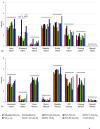Chicken fillets subjected to UV-C and pulsed UV light: Reduction of pathogenic and spoilage bacteria, and changes in sensory quality
- PMID: 30122794
- PMCID: PMC6084340
- DOI: 10.1111/jfs.12421
Chicken fillets subjected to UV-C and pulsed UV light: Reduction of pathogenic and spoilage bacteria, and changes in sensory quality
Abstract
We have compared the efficacy of continuous ultraviolet (UV-C) (254 nm) and pulsed UV light in reducing the viability of Salmonella Enteritidis, Listeria monocytogenes, Staphylococcus aureus, enterohemorrhagic Escherichia coli, Pseudomonas spp., Brochothrix thermospacta, Carnobacterium divergens, and extended-spectrum β-lactamase producing E. coli inoculated on chicken fillet surface. Fluences from 0.05 to 3.0 J/cm2 (10 mW/cm2, from 5 to 300 s) used for UV-C light resulted in average reductions from 1.1 to 2.8 log cfu/cm2. For pulsed UV light, fluences from 1.25 to 18.0 J/cm2 gave average reductions from 0.9 to 3.0 log cfu/cm2. A small change in the odor characterized as sunburnt and increased concentration of volatile compounds associated with burnt odor posed restrictions on the upper limit of UV treatment, however no sensory changes were observed after cooking the meat. Treatments under modified atmosphere conditions using a UV permeable top film gave similar or slightly lower bacterial reductions.
Practical applications: Ultraviolet (UV) light may be used for decontaminating the surface of food products and reduce viability of pathogenic and spoilage bacteria. Exposure of raw chicken fillet surface to various doses of continuous UV-C or pulsed UV light proposed in the present work represent alternatives for microbiological improvement of this product. Chicken fillets can be treated in intact packages covered with UV permeable top film, thus avoiding recontamination of the meat. UV-C light treatment is a low cost strategy with low maintenance, whereas pulsed UV light involves more elaborate equipment, but treatment times are short and less space is required. Both methods can be helpful for producers to manage the safety and quality of chicken fillets.
Figures






Similar articles
-
Comparison of UV-C and Pulsed UV Light Treatments for Reduction of Salmonella, Listeria monocytogenes, and Enterohemorrhagic Escherichia coli on Eggs.J Food Prot. 2018 Jan;81(1):6-16. doi: 10.4315/0362-028X.JFP-17-128. J Food Prot. 2018. PMID: 29220202
-
Efficacy of UV light treatment for the microbiological decontamination of chicken, associated packaging, and contact surfaces.J Food Prot. 2011 Apr;74(4):565-72. doi: 10.4315/0362-028X.JFP-10-356. J Food Prot. 2011. PMID: 21477470
-
Inactivation of Salmonella spp., pathogenic Escherichia coli, Staphylococcus spp., or Listeria monocytogenes in chicken purge or skin using a 405-nm LED array.Food Microbiol. 2017 Jun;64:135-138. doi: 10.1016/j.fm.2016.12.011. Epub 2016 Dec 22. Food Microbiol. 2017. PMID: 28213017
-
Use of germicidal UV light to reduce low numbers of Listeria monocytogenes on raw chicken meat.J Food Prot. 2013 Nov;76(11):1969-71. doi: 10.4315/0362-028X.JFP-13-181. J Food Prot. 2013. PMID: 24215703
-
Effect of inoculum size, bacterial species, type of surfaces and contact time to the transfer of foodborne pathogens from inoculated to non-inoculated beef fillets via food processing surfaces.Food Microbiol. 2017 Apr;62:51-57. doi: 10.1016/j.fm.2016.09.015. Epub 2016 Sep 24. Food Microbiol. 2017. PMID: 27889165
Cited by
-
Effect of UV-C Irradiation and Lactic Acid Application on the Inactivation of Listeria monocytogenes and Lactic Acid Bacteria in Vacuum-Packaged Beef.Foods. 2021 May 28;10(6):1217. doi: 10.3390/foods10061217. Foods. 2021. PMID: 34071197 Free PMC article.
-
Investigating the Use of Ultraviolet Light Emitting Diodes (UV-LEDs) for the Inactivation of Bacteria in Powdered Food Ingredients.Foods. 2021 Apr 8;10(4):797. doi: 10.3390/foods10040797. Foods. 2021. PMID: 33917815 Free PMC article.
-
Effect of Pulsed Light on Quality of Shelled Walnuts.Foods. 2022 Apr 19;11(9):1186. doi: 10.3390/foods11091186. Foods. 2022. PMID: 35563906 Free PMC article.
-
Survival of Escherichia coli in Airborne and Settled Poultry Litter Particles.Animals (Basel). 2022 Jan 24;12(3):284. doi: 10.3390/ani12030284. Animals (Basel). 2022. PMID: 35158607 Free PMC article.
-
Impact of a Combination of UV-C Irradiation and Peracetic Acid Spray Treatment on Brochothrix thermosphacta and Yersinia enterocolitica Contaminated Pork.Foods. 2021 Jan 20;10(2):204. doi: 10.3390/foods10020204. Foods. 2021. PMID: 33498361 Free PMC article.
References
-
- Angelini, P. , Merritt, C. , Mendelsohn, J. M. , & King, F. J. (1975). Effect of irradiation on volatile constituents of stored haddock flesh. Journal of Food Science, 40(1), 197–199. 10.1111/j.1365-2621.1975.tb03770.x - DOI
-
- Anonymous . (2000). Lebensmittelbestrahlungsverordnung vom 14. Dezember 2000 (BGBl. I S. 1730), die zuletzt durch Artikel 62 der Verordnung vom 31. August 2015 (BGBl. I S. 1474) geändert worden ist. Germany.
-
- Batzer, O. F. , & Doty, D. M. (1955). Nature of undesirable odors formed by gamma irradiation of beef. Journal of Agricultural and Food Chemistry, 3(1), 64–67. 10.1021/Jf60047a009 - DOI
-
- Bintsis, T. , Litopoulou‐Tzanetaki, E. , & Robinson, R. K. (2000). Existing and potential applications of ultraviolet light in the food industry ‐ A critical review. Journal of the Science of Food and Agriculture, 80, 637–645. 10.1002/(Sici)1097-0010(20000501)80:6<637::Aid-Jsfa603>3.0.Co;2-1 - DOI - PubMed
LinkOut - more resources
Full Text Sources
Other Literature Sources
Miscellaneous
